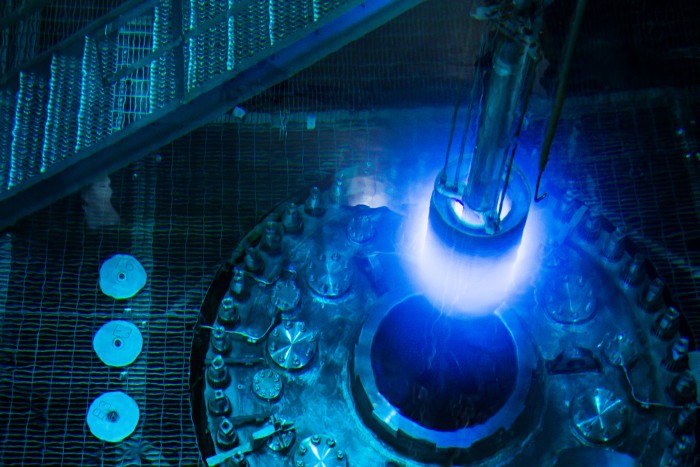NASA runs out of plutonium 238

High Flux Isotope Reactor at Oak Ridge National Laboratory produces small amounts of plutonium-238 for NASA, enriching neptunium-237
Sluggish nuclear fuel production threatens NASA's plans to launch spacecraft using thermoelectric generators. If the problem is not solved, then you have to limit yourself to solar energy.
The ideal fuel is plutonium-238 (Pu-238). Four kilograms of fuel is enough to provide the ship with energy for decades. NASA has spent 140 kg of plutonium in its history, including on experiments under the Apollo program, on the Galileo mission to Jupiter, and on sending the Pioneer and Voyager devices. Right now, plutonium is providing heat and electricity to the Curiosity rover, the Cassini orbiting station at Saturn, and the New Horizons spacecraft flying to Kuiper’s belt.
Plutonium would be very useful for robotic probes, which can plunge into the depths of the ice of satellites in the solar system, where there are underground oceans of water. For aircraft that will fly in the atmospheres of other planets and explore new territories. For ships to travel on lakes and rivers of liquid methane and ethane on the surface of Titan. For many other missions. But plutonium is ending, and there is a suspicion that nuclear fuel will have to be abandoned if a strong-willed political decision is not made.
In the United States, plutonium-238 isotope production was stopped in 1988. The US Department of Energy signed a five-year agreement in 1992 on the purchase of an isotope from Russia in the amount of 10 kg and the possibility of increasing supplies to no more than 40 kg. As part of the contract, several contracts were concluded, the agreement was extended. In 2009, supplies were interrupted due to a restructuring of the Russian nuclear industry, and NASA is now in a difficult position, writes Scientific American.
Attempts by the Department of Energy to establish Pu-238 enrichment at the Oak Ridge National Laboratory do not give an acceptable result: the production of the neptunium-237 isotope is too small.
Currently, NASA’s reserves are only 35 kilograms of Pu-238, and the radioactive decay of 18 out of 35 kilograms is too weak to be used in NASA’s existing thermoelectric generators. According to experts, 17 kg of fuel will be enough for only four generators, one of which is already reserved for the rover as part of the Mars 2020 mission.
In 2013, after a twenty-five-year hiatus, the US Department of Energy resumed production of plutonium-238 at the Oak Ridge National Laboratory, but the project encountered technical difficulties and was already behind schedule, so it was unlikely to reach the planned capacity of 1.5 kg of plutonium per year by 2021 year. Instead, engineers are talking about producing 0.5 kg per year by 2019.
The problem was repeatedly raised in Congress, trying to fetch information from NASA about the current state of affairs, about the amount of plutonium needed and possible ways to get it, but the National Space Agency remains silent. There was also an attempt to pass the Efficient Space Exploration Act to plan NASA's material support, but he was also stuck in parliamentary committees.
In other words, now NASA does not have a plan and a clear understanding of what to do next, Scientific American writes. Independent experts criticize NASA’s position, which claims no additional plutonium reserves are needed. Like, and the current stock is enough for the planned missions. But this is a classic example of a vicious circle. There is enough current stock because few missions are planned. Few missions are planned because plutonium is lacking. If there was more fuel, then it would probably be found where to use it.
For example, for several decades now, scientists have been dreaming of sending a probe to Europe, the satellite of Jupiter, where life could theoretically exist under the ice. But these plans are constantly being delayed due to too much plutonium needed. So, the latest Jupiter Europa Orbiter project required 17.6 kg of Pu-238, that is, more than NASA had.
The problem is compounded by the fact that in 2013, Congress and the White House passed on to NASA the costs of restarting the plutonium production line and the operation of research laboratories. Now these costs amount to $ 50 million per year. Since the costs fell on the shoulders of NASA, it was necessary to reduce funding for some scientific and technical programs, including programs to create new types of generators that could reduce plutonium consumption. Again, a vicious circle.
Engineers try to solve the problem differently. For example, there is an idea to launch to Europe not a probe on plutonium, but a solar-powered orbiter, which will perform a number of ingenious maneuvers, approaching the surface at a close distance.
In some respects, solar panels even outperform thermoelectric generators: they weigh less and are deployed at the required power, depending on the needs of the device. So, for a mission to Europe, you need solar panels with an area of 50 m 2 . This type of battery will be tested on the Juno device, which will arrive at Jupiter in July 2016.
Faced with a deficit of plutonium, engineers are forced to rely on solar energy and improve technology: to increase the efficiency of solar cells using concentrators and mirrors, panels of a new design.
But no matter how hard the engineers try, there are missions that are fundamentally impossible to provide with solar energy. Anyway, if you think about it, the same Fila descent vehicle would now continue to operate on comet 67P / Churyumov-Gerasimenko if it had a thermoelectric generator, and not solar panels. In general, one will either have to negotiate with Russia, or make a political decision to resume the nuclear program, which was stopped after the end of the Cold War.
